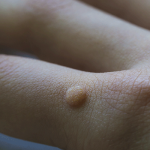When people see dry, flaky skin on their scalp, they usually think it is dandruff. However, sometimes, it isn’t as simple as that. If you are suffering from an overabundance of dry skin on your scalp, face or chest, it could be seborrheic dermatitis.
What is seborrheic dermatitis?
Seborrheic dermatitis is a skin condition characterized by dry, flaky skin. In infants, it is often called “cradle cap.” In adults, it usually appears in areas of higher oil concentration, like the scalp, face and upper chest.
This chronic condition affects 3% to 5% of people worldwide. Although it is more common in men, the condition is usually more severe in women.
Despite its prevalence, the causes and treatments of seborrheic dermatitis are somewhat of a mystery. People often have to work with a dermatologist and may need to try several different treatment options before finding one that works best for them.
Possible causes of seborrheic dermatitis
Researchers have not specifically identified the root cause of seborrheic dermatitis. However, they have identified several possible causes of this condition, such as:
- Oily skin – People with seborrheic dermatitis often find an oily, yellow, flaky buildup on their skin in areas of the body with the most oil. That said, a person with dry skin can still develop it.
- Malassezia yeast – Although Malassezia yeast is present on everyone’s skin, it can cause this type of dermatitis when too much is present.
- Stress and weather – The condition can be aggravated by stress and is more prevalent in humid climates.
- Immune response – If a person suffers from another condition that places stress on their body, that condition can cause the negative symptoms to flare.
Symptoms
People often complain that this condition causes discomfort and embarrassment. Common symptoms associated with seborrheic dermatitis include:
- A red, white or yellow rash – Like many skin conditions, the color of the rash can vary. Often, the rash appears white or yellow. If the area is irritated, the skin around it may look red.
- Itchy skin – The skin can be quite itchy in the affected areas.
- Dandruff – Scratching the affected areas can lead to flaking and dandruff or cause you to develop a thicker layer of flaky skin.
- Hypopigmented patches – Seborrheic dermatitis in individuals with skin of color may present differently. People with darker skin may experience scaly, hypopigmented patches.
Diagnosis
In most cases, dermatologists diagnose seborrheic dermatitis based on its appearance and location. Sometimes they will take a scraping or a skin biopsy to rule out other skin conditions before determining a final diagnosis.
It is important to obtain an accurate diagnosis before a treatment can be applied effectively. Seborrheic dermatitis can be present with other skin and physical conditions, so working with a dermatologist will ensure you receive the correct diagnosis.
Treatment for seborrheic dermatitis
Seborrheic dermatitis has several potential treatments. Finding the right one will depend on your skin condition, the cause of the condition and how your skin responds to the treatments recommended by your dermatologist.
There are a wide range of treatment options for seborrheic dermatitis. Some can be performed at home, while others will require a prescription from a dermatologist.
Topical treatments
- Antifungal creams – Antifungal creams don’t specifically treat seborrheic dermatitis, but they do treat the overproduction of Malassezia yeast. These creams are applied topically and can be prescribed by your dermatologist.
- Shampoo – Medicated shampoos with selenium sulfide, zinc pyrithione or coal tar can reduce inflammation and scaling. Many of these are available over the counter, but it is best to talk to your dermatologist about your condition before you try them.
- Other dermatological treatments – The dermatologists at Columbia Skin Clinic have years of experience treating seborrheic dermatitis and can create a custom treatment plan for your skin’s specific needs.
Prevention through self-care
- Avoid using harsh or highly fragranced products – Use fewer hair products in general, if possible.
- Wash regularly, but not too regularly – Washing your hair or face too often can cause your skin to begin overproducing oil. Not washing enough can also be a problem, causing oily buildup to remain and spread. Your dermatologist can advise you on the best soaps to use.
- Avoid scratching – The affected areas are more sensitive, so scratching them will cause more flaking and irritation.
- Keep the area moisturized – Believe it or not, letting your skin get too dry can worsen seborrheic dermatitis. Moisturizing creams for sensitive skin can help. For a list of recommended products, contact your dermatologist.
- Relax – Carve out a part of your day dedicated to relaxation and the alleviation of stress, including calming hobbies that are important to you.
- Study your diet – Diet can contribute to overly oily skin and disrupt your body’s regular immune responses. Experiment and exclude common problem foods to see if that prevents flare-ups.
- Don’t forget your beard – It is important to wash and treat your beard like you would in your hair or other affected areas of your face.
When should you see a dermatologist?
Columbia Skin Clinic’s dermatologists recommend scheduling a consultation to discuss your symptoms if you are unhappy with your skin. Because seborrheic dermatitis is often seen with other conditions, simply researching on your own may not lead you to the correct conclusion.
Speak with a dermatologist if:
- The condition worsens over time – When you start seeing symptoms, note what your skin looks like and how it has changed. If it starts to spread or become more irritated, contact us to discuss treatment options.
- The treatments you are trying aren’t working – A board-certified dermatologist h has expertise in successfully treating skin conditions like yours. Don’t suffer through home remedies that aren’t working.
- The affected area is large – Don’t waste time trying to figure things out on your own when a skin condition is quickly spreading. The sooner you are seen and under professional treatment, the faster your condition can begin healing.
- When combined with another condition – Seborrheic dermatitis is often seen with psoriasis. When the conditions are combined, they are more challenging to treat.
Get help with your seborrheic dermatitis
Finding the right treatment and lifestyle to treat your skin condition can take time. The first step is to contact a dermatologist and create a plan for your skincare.
The experienced dermatologists at Columbia Skin Clinic have years of experience treating difficult skin conditions like seborrheic dermatitis. You can trust that our staff will work with you to develop a treatment plan to alleviate your symptoms as best as possible. Contact our office today to schedule your appointment.






